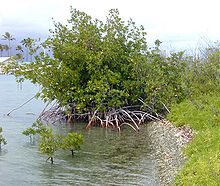Dominance (ecology)
This article needs additional citations for verification. (June 2021) |

Rhizophoraceae (mangroves) dominate tropical tidal swamps
Ecological dominance is the degree to which one or several species have a major influence controlling the other species in their ecological community (because of their large size, population, productivity, or related factors)[1] or make up more of the biomass.
Most ecological communities are defined by their dominant species.
- In many examples of wet woodland in western Europe, the dominant tree is alder (Alnus glutinosa).
- In temperate bogs, the dominant vegetation is usually species of Sphagnum moss.
- Tidal swamps in the tropics are usually dominated by species of mangrove (Rhizophoraceae)
- Some sea floor communities are dominated by brittle stars.
- Exposed rocky shorelines are dominated by sessile organisms such as barnacles and limpets.
See also[]
- National Vegetation Classification, a system for classifying British plant communities by their dominant species
- Monodominance
References[]
External links[]
Categories:
- Habitats